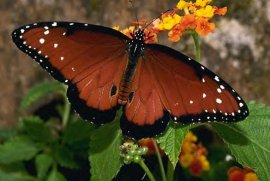Fritillaries and Orange Patterned Butterflies
Description
3-3 3/8" (76-86 mm). Large. Deep fox-brown above and below with black margins and finely lined black veins. Fine white dots speckle margins, larger ones occur on FW tip and along margin. West of Mississippi, populations have white scaling along HW veins above and are somewhat lighter.
Similar Species
Monarch larger, orange with blacker veins. Tropic Queen orange-brown, pale toward outer edge. Dark Florida Viceroy has strong black line arcing across HW.
Life Cycle
Egg, 3/64" h x 9 /256" w (1.2 x 0.9 mm), light, oval; laid on milkweeds and related plants (Asclepiadaceae). Caterpillar, to 2" (51 mm), brownish-white, with dark brown-black and light yellow crossbands, and yellow or yellow-green side stripes; has 3 pairs of dark filaments, 2 longer pairs toward front and 1 shorter pair near rear. Blunt chrysalis, to 1 1/8" (28 mm), green with gold spots and prominent abdominal suture. Host plants blunt-leaved milkweed (Asclepias amplexicaulis) and rambling milkweed (Sarcostemma hirtellum).
Flight Successive broods; April-November, briefer in North, perhaps all year in Texas.
Habitat
Deserts, coasts, prairies, watercourses, and other open places with milkweeds.
Range
Nevada and S. California east to Kansas and Texas, around Gulf to Florida and S. Georgia, south to South America.
Discussion
The Queen cannot withstand cold winters. Records for northwestern Utah, Nebraska, and Kansas represent temporary immigrations. The Viceroy, an accomplished mimic resembling the Monarch in its northern, summer range, has a dark russet race in the South, which mimics the Queen. Male Queens possess brushes, or hair pencils, within the tips of their abdomens. As courtship begins these brushes are extended, releasing a compound that subdues the female during mating.


